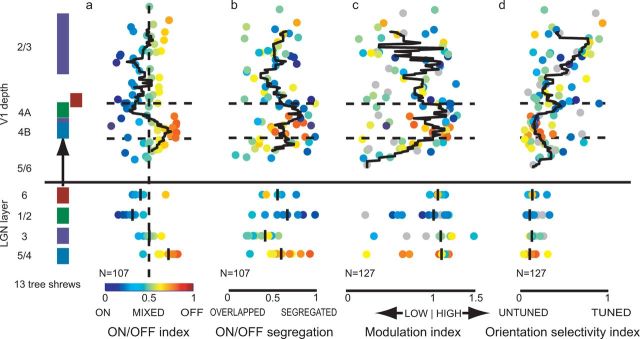Figure 4.
Laminar organization of receptive field properties for all cells. Left, Thalamocortical projection pattern in the tree shrew; colors in cortical layers match the colors of the LGN layers that provide direct thalamocortical input (Raczkowski and Fitzpatrick, 1990; Usrey et al., 1992). a, ON/OFF index values for LGN and V1 cells; the depths of V1 cells have been reconstructed and projected onto a “standard cortex” (see Materials and Methods). The black line indicates the sliding median value using a window size of 200 μm and a step size of 10 μm. Median values for each LGN layer are indicated by a black bar. The color of each cell matches the ON/OFF index color scale at bottom, and this ON/OFF index color is used for the same cell in all panels. As in previous studies, cells in LGN 1/2 and V1 4A are dominated by ON responses, while cells in LGN 4/5 and V1 4B are dominated by OFF responses (Conway and Schiller, 1983; Kretz et al., 1986; Holdefer and Norton, 1995). The transition between ON- and OFF-dominated responses in layer 4 is abrupt as expected and serves as a validation of the laminar reconstruction methods. b, ON/OFF segregation index (conventions are as in a). Color indicates the cell's ON/OFF index value. There is relatively high segregation of ON and OFF inputs in LGN layers 1, 2, 4, and 5 and cortical layer 4, whereas segregation is more variable in cortical layer 2/3. c, Modulation index values, conventions as in a). Color indicates the cell's ON/OFF index value; gray indicates cells where ON/OFF responses were not measured or not significant (ANOVA, p < 0.05). While a majority of LGN and V1 layer 4 cells exhibit high modulation index values, cells in layer 2/3 are more variable. A majority of layer 2/3 cells had modulation index values of <1, but a considerable minority exhibited high modulation. d, Orientation selectivity index values (conventions are as in c). There is substantial sublaminar organization of orientation selectivity. The top of V1 layer 4A exhibits increased orientation selectivity compared to the rest of layer 4, and orientation selectivity increases markedly as one moves superficially in V1 layer 2/3.

